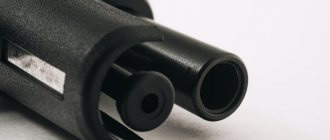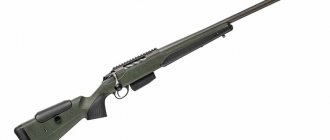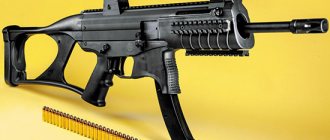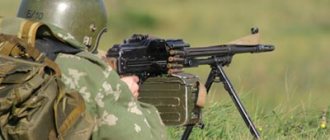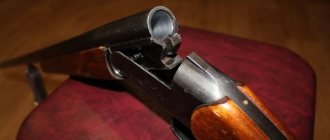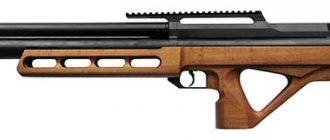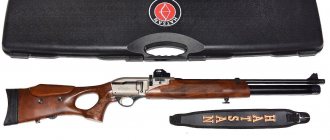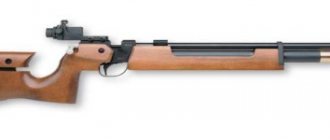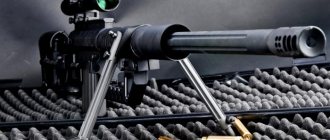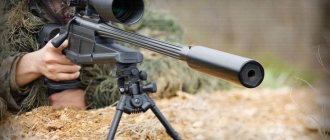Modernization of the IZH 60 rifle
Despite its stylish, even slightly futuristic appearance, this rifle has long been rightfully considered a classic of air guns. Anyone who at least once felt the pleasant weight of this two-kilogram rifle in his hands, rested his shoulder on the adjustable stock, and finally pressed the adjustable trigger, remained captive of that unique combination of chilling calm and adrenaline that this amazing weapon can give the shooter.
The main feature of the Izh-60 is the use of spring-piston mechanics, driven by a side lever. The spring-piston mechanism is located almost entirely in the butt of the rifle. This design allows you to maintain complete immobility of the barrel, which has a beneficial effect on the accuracy of fire.
To fully unleash the full rich potential of the Izh-60, you can perform a number of simple manipulations with it: 1 – Izhevsk products rarely have low build quality. However, it is recommended to disassemble the rifle; fortunately, the simplicity of the design allows this to be done very easily: three screws are unscrewed, in the area of the butt (19), rammer (22) and forend (24), respectively. After disassembly, check the attachment points of the parts and, if necessary, tighten all screws by hand. It is also recommended to slightly upgrade the limiter (13) by attaching a rubber or leather pad to the end to extend its service life. As a rule, the standard piston cuff is also replaced with a softer leather one.
2 - To further increase shooting accuracy, you can install a collimator or optical sight on the Izh-60. This is done manually, without the use of any tools: the standard sighting bar (5) is unscrewed, and a new device is put in its place.
The collimator sight is powered by two universal chargers STs-21. Continuous operation time – 50 hours. The effective firing range could potentially be increased from 10 to 20-25 meters, approaching the maximum effective range.
3 – It is possible to increase the power of the rifle in two ways: by increasing the piston stroke (10) and replacing the standard spring with a stiffer one. The fact is that the design has a certain piston stroke reserve (about 5-7 mm). If you add an additional plate to the piston, a little more than one millimeter thick. Thus, when cocking the rifle, the sear (21) will rest against this plate, pressing the spring and thereby increasing the piston stroke by 3-5 mm. The initial speed of the bullet can reach 180 m/s. A possible unpleasant consequence could be a decrease in resource.
Replacing the spring is an even more complicated process (there is a danger of breaking the cocking lever and rammer). You can use a spring from MP 38, MP 145 or cut MP 137, MP 512, GC 155, GC 440. There are a lot of options, but it is unlikely that you will be able to achieve a speed above 180 m/s. Also, a slight increase in power is facilitated by sealing the rammer (8), because this reduces air leakage.
4 – There is a theoretical possibility of transferring the Izh 60 to a new class - pneumoballoon pneumatics (PCP). In practice, the prospect of attaching a massive CO2 cylinder to the elegant rifle body does not please even the most notorious upgrade lovers.
Conclusion: Izh 60 is one of the simplest and most reliable air rifles. At the same time, the inherent potential and the possibility of modernization make it possible to increase the basic characteristics of the weapon by an order of magnitude. The design allows for quick replacement of damaged parts. You can purchase them, and in some cases even make them yourself. As a rule, repairs come down to disassembling, identifying the problem and replacing damaged parts.
.
Upgrade IZH-60
The very first thing that can be done is a seal on the rammer. When you shoot, do you notice how much “blow” there is from the loading window? This can be cured with a simple operation. You can sharpen the groove on the rammer on a lathe, but I sharpened it with a needle file, it was necessary to go to the workshop for scrap - about 1.5 mm deep. Take an elastic band (preferably rubber that is resistant to mineral oils), put it on, and trim it with a file. The seal needs to be lubricated periodically. The result is that the “blow” from the loading window has stopped; the seal has been in place for more than two years. Yes, in order for the seal to last longer, you need to round off the sharp edges of the box in the area of the groove for loading the bullet. Another option (based on conference materials): rubber seals from the valve of a disposable lighter fit ideally into grooves about 1 mm deep. By the way, in this photo you can see that there is a metal ball on the “handle” of the rammer - it becomes much more comfortable to “close the shutter.”
When you shoot, do you notice how much “blow” there is from the loading window? This can be cured with a simple operation. You can sharpen the groove on the rammer on a lathe, but I sharpened it with a needle file, it was necessary to go to the workshop for scrap - about 1.5 mm deep. Take an elastic band (preferably rubber that is resistant to mineral oils), put it on, and trim it with a file. The seal needs to be lubricated periodically. The result is that the “blow” from the loading window has stopped; the seal has been in place for more than two years. Yes, in order for the seal to last longer, you need to round off the sharp edges of the box in the area of the groove for loading the bullet. Another option (based on conference materials): rubber seals from the valve of a disposable lighter fit ideally into grooves about 1 mm deep. By the way, in this photo you can see that there is a metal ball on the “handle” of the rammer - it becomes much more comfortable to “close the shutter.”
The second is the replacement of the standard polymer cuff with a leather one (or, as on imported air rifles, a nylon cuff (?), which shows better results compared to leather). When the rifle is used intensively, the standard PVC seal breaks down quite quickly: in the first few months the sealing edge wears out quite quickly (due to poor-quality processing of the inner surface of the cylinder), in subsequent months the edge of the new seal wears out less intensively, but the front part cracks cuffs from impacts of the piston on the front part of the cylinder.
| 1 — bushing, 2 — washer, 3 — cuff, 4 — piston. The bushing (item 1) should be shaped like the standard fungus on the piston. |
On early models of Izhevsk pneumatics (IZH-22, IZH-38 early releases) leather cuffs were installed. In this case, the cuff was attached to the piston using a screw, the thread of which was cut off during the firing process from the impact of this same piston on the front wall of the cylinder. But the leather cuff lasted much longer than modern polymer cuffs. In current models, the attachment point for the cuff to the piston has the shape of a mushroom, onto which the cuff itself is mounted. This excludes any failure of this unit. The point of the upgrade is to combine all the positive aspects of these designs, i.e. a leather cuff and its attachment to the piston in the form of a mushroom.
To do this, you need to cut off the fungus on a lathe and make a sleeve, the dimensions of which completely match the dimensions of the fungus on the piston. This bushing is secured to the piston using an M5 countersunk screw. The peculiarity of the new design is that it is now possible to install a leather cuff, but at the same time the possibility of using a standard polymer one is not lost. (Author of the idea Konstantin Storublenkov 2:5020/1125.3)
By the way, if you install a standard cuff, you should give preference to a white translucent polyethylene cuff (like a lid for a jar). They are more elastic and less susceptible to wear. When comparing the speed of bullets with a polyethylene cuff and the one installed at the factory (dark, hard), the advantages are on the side of the former.
The next thing is that you can install an optical sight (as is done on my rifle). I would like to warn you against purchasing German sights designed specifically for pneumatics. I had one of these (4x20) and I can’t say anything good about it. The adjustment of the sight gets lost both during shooting and during transportation, it is quite tedious to adjust (there is no ratchet or divisions), and in general the quality is such that it looks like it was made not in Germany, but in China, and purely with a hammer and a file. The pneumatic sight from Belomo is not far behind its German brother. It has the same magnification (4x20) and exactly the same disadvantages, although the workmanship is slightly higher. If you have a problem choosing a scope, you should pay attention to models for firearms. For example, a pretty good 3.5x32 sight made by LOMO. And I have a 5x35 scope from an unknown manufacturer (passport lost. However, it seems to me that the ideal scope in terms of price-quality ratio would be a 3-9x40 made in Belarus. This is a scope with variable magnification (from 3x to 9x), which allows you to get the maximum out of your rifle possibilities.More details about choosing an optical sight can be read in the article by V. Schmidt.
I would like to warn you against purchasing German sights designed specifically for pneumatics. I had one of these (4x20) and I can’t say anything good about it. The adjustment of the sight gets lost both during shooting and during transportation, it is quite tedious to adjust (there is no ratchet or divisions), and in general the quality is such that it looks like it was made not in Germany, but in China, and purely with a hammer and a file. The pneumatic sight from Belomo is not far behind its German brother. It has the same magnification (4x20) and exactly the same disadvantages, although the workmanship is slightly higher. If you have a problem choosing a scope, you should pay attention to models for firearms. For example, a pretty good 3.5x32 sight made by LOMO. And I have a 5x35 scope from an unknown manufacturer (passport lost. However, it seems to me that the ideal scope in terms of price-quality ratio would be a 3-9x40 made in Belarus. This is a scope with variable magnification (from 3x to 9x), which allows you to get the maximum out of your rifle possibilities.More details about choosing an optical sight can be read in the article by V. Schmidt.
After installing an optical sight, the muzzle with the front sight becomes redundant and interferes with aiming using the optics. For aesthetic reasons, you can replace it with a new one. To minimize changes in the balance of the rifle, it is more advisable to use aluminum as a material. Although someone Ian Pellant advises installing a steel muzzle to improve the weight distribution and balance of the rifle. Here's what he writes: “After removing the standard sights (front and rear sights) and installing a Tasco AccuDot sight, a problem arose with the balance shifting towards the butt. In addition, when firing, there was too much toss of the barrel. The problem was solved by installing a Vortek “Accurizer” muzzle. It must be said that his sight is closer to the butt, so the balance is shifted. For me, the center of gravity of the optical sight is located almost at the center of gravity of the rifle (still rather closer to the barrel), which is why aluminum was chosen as the material for the muzzle. In my case, the dimensions of the muzzle are as follows:
Well, the last, most controversial element of the upgrade is replacing the standard spring with a more powerful one, for example from the Gamo Hunter-440 rifle. There are two opinions regarding the installation of a more powerful spring: some believe that with a standard spring (or, in extreme cases, with a cut spring from IZH-38/MR-512), the IZH-60 is an ideal target rifle and a more powerful spring only worsens its accuracy ( which is actually true). With a new standard spring, a seal installed on the rammer and a new polyethylene cuff, the DC bullet speed from my rifle is 145-150 m/s.
If you want to install a more powerful spring, let’s consider this issue in a little more detail. A spring from Gamo Hunter-440 costs about 250 rubles. (price as of July 2000). The bullet speed of this rifle is about 300 m/s; of course, this value cannot be achieved from the IZH-60, but I think it is possible to achieve 200 m/s, which is actually not bad at all. You can purchase such a spring in weapon repair shops (for example, in St. Petersburg in a workshop on Popova St., 23). The spring needs to be shortened, leaving 24-25 turns.
You can also install a spring from IZH-38, cutting off about 11-12 turns. In this case, the bullet speed increases to approximately 170 m/s. In Murmansk it is difficult to find a spring in stores, not only for the Hunter, but even for the IZH-38 (more precisely, according to the sellers, they have never brought springs for pneumatics at all). But on the Internet there is a wonderful office - “Kalashnikov and K”, located at okhotnik.guns.ru. There I ordered 4 springs for IZH-38. They cost me (including postage via special communications) 100 rubles. The order was completed quite quickly (2 weeks). Brief impressions. The cocking has become stiffer, the part that connects the lever and the piston all cracks and creaks when you cock. When the shot was fired, there was a lot of white smoke, although there was nothing with the standard spring, which I had not changed for a year and a half. I measured the speed of the bullet with a pendulum (for more details on the measurement, see here) and this is what happened:
- standard spring (2.5 mm wire) DC bullet speed - 144-145 m/s;
- spring from IZH-38 (2.8 mm wire) DC bullet speed - 165-167 m/s.
DC assumed the mass of the bullet to be 0.506 g. Here it must be said that the cuff on this IZH-60 has not been changed for about two years (well, they don’t sell them here), with a new good cuff the result would have been better. By the way, I was surprised when I removed the standard spring - it practically did not sag compared to the new standard one. It became shorter by 0.5 cm. And, one more thing: the shot became quieter, without a metallic clang. Just cotton.
| Standard spring dimensions | Gamo Hunter-440 | IZH-38 (MR-512) | |
| Wire diameter, mm | 2.5-2.6 (according to various sources from 2.3) | 3,0 | 2,8 (2,8) |
| Spring diameter, mm | 19,5-20,0 | 19,8 | 19,5-20,0 (19,5-20,0) |
| Number of turns of wire | 32-33 | 34 | 39-41 (34-35) |
| Length with free state, mm | 210 | 285 | ? (220) |
| Length with compressed state, mm | 80 | 102 | 112 (98) |
Alexander Russkov 2:5000/177.2:
Spring from the front fork of the Karpaty moped and others like it. Standard spring wire 3 mm, 38 turns in 4 mm increments, outer diameter 19 mm, inner diameter 13 mm.
SG:
You can also try the return spring from the A-12.7 machine gun, cut approximately in half. The result is a multi-core spring... True, the cocking rod often has to be changed, unless, of course, it is altered, and of course the piston too...
By the way, after installing a more powerful spring, you will need to replace the connection connecting the cocking lever and the piston. It is made of 0.7 mm plate and cannot withstand heavier loads. The easiest way is to make it again from a thicker steel sheet (1.0-1.5 mm).
A. Nazarov
